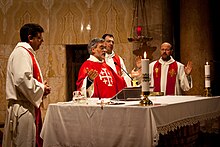Concelebration

In
Concelebration is often practiced by ministers of Churches that are in full communion with one another, e.g. the Anglican Communion and the Old Catholic Church.[2]
History
Concelebration occurs in
Practice
Roman Catholic Church
It is known from early Christian art uncovered through
- At the ordination of a priest, where the newly ordained concelebrated with the ordaining bishop, and;
- At the consecration of a bishop, when the newly consecrated bishop concelebrated with the consecrating bishop.
The liturgical reforms following the Second Vatican Council provided for the return to the practice of concelebration of Mass.[6] An example of studies in the immediate post-conciliar years regarding the matter of this liturgical practice is the volume of essays by a distinguished group of Roman Catholic churchmen (Burkhard Neunheuser et al.) titled Théologie et pratique de la Concélébration (Maison Mame, 1967, translated from the Italian original, La Concelebrazione, which Edizioni Queriniana had published). Thus, communities with more than one priest could have several priests concelebrate the Eucharist rather than each celebrating it in private, emphasizing its communal nature. Liturgical law allows concelebration on any occasion, but it is more common on feasts, especially those at which the (arch)bishop traditionally presides, such as the Chrism Mass on Maundy Thursday. If a diocese or archdiocese is vacant and an apostolic administrator that is a/an (arch)bishop is not able to celebrate, a selected group of priests within the (arch)diocese will then concelebrate the feast with one of them being a principal celebrant.
An article in La Civiltà Cattolica of 2 October 2004[7] pointed out that the reintroduction of Eucharistic concelebration in the Latin Church was in line with the teaching of Pope Pius XII, who taught that the two "assistant bishops" at the consecration of a new bishop should speak all the words of consecration, thus indicating clearly that, instead of being merely witnesses, they were co-consecrating, concelebrating the sacrament of orders.[8] He applied the same rule to concelebration of the Eucharist (at that time in use only at ordination to episcopacy and to priesthood) in his talk of 22 September 1956.
Anglican Communion
Traditionally, concelebration was not practiced or permitted in Anglican churches.[citation needed] However, the Book of Common Prayer of the Episcopal Church directs other clergy to "stand with the celebrant at the Altar, and join in the consecration of the gifts, in breaking the Bread, and in distributing Communion."[1][9]
References
- ^ ISBN 9780898697018. Retrieved 2016-12-27.
- ISBN 9788172145163.
Bishop Derek Rawcliffe, former Bishop of Glasgow and Galloway, celebrated the Anglican/Old Catholic Eucharist in English. I and a few more priests had the privilege of concelebrating with him. There was a spirit of unity and fellowship among the delegates, despite belonging to different Churches, countries and speaking different languages
- ^ "Constitution on the Sacred Liturgy Sacrosanctum Concilium". Archived from the original on 2008-02-21. Retrieved 2008-02-09. Chapter 2 Subsection 57.
- ISBN 9780814658567. Retrieved 27 December 2016.
- ^ Adomnán of Iona (1995) [c. 700]. Life of St Columba. Penguin Books.
- ^ a b
 Herbermann, Charles, ed. (1913). "Concelebration". Catholic Encyclopedia. New York: Robert Appleton Company.
Herbermann, Charles, ed. (1913). "Concelebration". Catholic Encyclopedia. New York: Robert Appleton Company.
- ^ La Civiltà Cattolica, 2 October 2003, page 45 and following
- ^ Apostolic Constitution Episcopali consecrationi AAS 43 (1945). 1944-11-30. p. 132.
- ^ "Holy Eucharist II: Concerning the Celebration". The (Online) Book of Common Prayer. 2007. p. 354.
